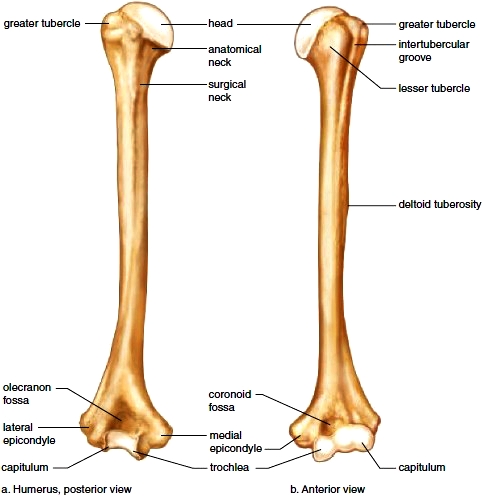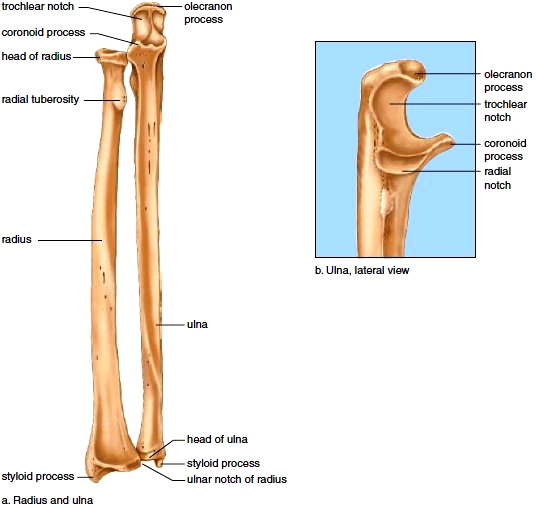Appendicular Skeleton
The appendicular skeleton contains the bones of the pectoral girdle, upper limbs, pelvic girdle, and lower limbs.
Pectoral Girdle
The pectoral girdle (shoulder girdle) contains four bones: two clavicles and two scapulae (Fig. 6.11). It supports the arms and serves as a place of attachment for muscles that move the arms. The bones of this girdle are not held tightly together; rather, they are weakly attached and held in place by ligaments and muscles. This arrangement allows great flexibility but means that the pectoral girdle is prone to dislocation.
Clavicles
The clavicles (collarbones) are slender and S-shaped. Each clavicle articulates medially with the manubrium of the sternum. This is the only place where the pectoral girdle is attached to the axial skeleton. Each clavicle also articulates with a scapula. The clavicle serves as a brace for the scapula and helps stabilize the shoulder. It is structurally weak, however, and if undue force is applied to the shoulder, the clavicle will fracture.
Scapulae
The scapulae (sing., scapula), also called the shoulder blades, are broad bones that somewhat resemble triangles (Fig. 6.11b). One reason for the pectoral girdle’s flexibility is that the scapulae are not joined to each other (see Fig. 6.4). Each scapula has a spine, as well as the following features:
acromion process, which articulates with a clavicle and provides a place of attachment for arm and chest muscles;
coracoid process, which serves as a place of attachment for arm and chest muscles;
glenoid cavity, which articulates with the head of the arm bone (humerus). The pectoral girdle’s flexibility is also a result of the glenoid cavity being smaller than the head of the humerus.
Upper Limb
The upper limb includes the bones of the arm (humerus), the forearm (radius and ulna), and the hand (carpals, metacarpals, and phalanges).
Humerus
The humerus (Fig. 6.12) is the bone of the arm. It is a long bone with the following features at the proximal end:
The scapulae (sing., scapula), also called the shoulder blades, are broad bones that somewhat resemble triangles (Fig. 6.11b). One reason for the pectoral girdle’s flexibility is that the scapulae are not joined to each other (see Fig. 6.4). Each scapula has a spine, as well as the following features:
acromion process, which articulates with a clavicle and provides a place of attachment for arm and chest muscles;
coracoid process, which serves as a place of attachment for arm and chest muscles;
glenoid cavity, which articulates with the head of the arm bone (humerus). The pectoral girdle’s flexibility is also a result of the glenoid cavity being smaller than the head of the humerus.
Upper Limb
The upper limb includes the bones of the arm (humerus), the forearm (radius and ulna), and the hand (carpals, metacarpals, and phalanges).
Humerus
The humerus (Fig. 6.12) is the bone of the arm. It is a long bone with the following features at the proximal end:
Figure 6.11 The pectoral girdle. a. Frontal view of the pectoral girdle (left side) with the upper limb attached.

Figure 6.11 The pectoral girdle. b. Posterior view of the right scapula.
head, which articulates with the glenoid cavity of the scapula;
greater and lesser tubercles, which provide attachments for muscles that move the arm and shoulder;
intertubercular groove, which holds a tendon from the biceps brachii, a muscle of the arm;
deltoid tuberosity, which provides an attachment for the deltoid, a muscle that covers the shoulder joint. The humerus has the following features at the distal end:
capitulum, a lateral condyle that articulates with the head of the radius;
trochlea, a spool-shaped condyle that articulates with the ulna;
coronoid fossa, a depression for a process of the ulna when the elbow is flexed;
olecranon fossa, a depression for a process of the ulna when the elbow is extended.
greater and lesser tubercles, which provide attachments for muscles that move the arm and shoulder;
intertubercular groove, which holds a tendon from the biceps brachii, a muscle of the arm;
deltoid tuberosity, which provides an attachment for the deltoid, a muscle that covers the shoulder joint. The humerus has the following features at the distal end:
capitulum, a lateral condyle that articulates with the head of the radius;
trochlea, a spool-shaped condyle that articulates with the ulna;
coronoid fossa, a depression for a process of the ulna when the elbow is flexed;
olecranon fossa, a depression for a process of the ulna when the elbow is extended.
Figure 6.12 Left humerus. a. Posterior surface view. b. Anterior surface view.



Radius
The radius and ulna (see Figs. 6.11a and 6.13) are the bones of the forearm. The radius is on the lateral side of the forearm (the thumb side). When you turn your hand from the “palms up” position to the “palms down” position, the radius crosses over the ulna, so the two bones are crisscrossed. Proximally, the radius has the following features: head, which articulates with the capitulum of the humerus and fits into the radial notch of the ulna; radial tuberosity, which serves as a place of attachment for a tendon from the biceps brachii; Distally, the radius has the following features: ulnar notch, which articulates with the head of the ulna; styloid process, which serves as a place of attachment for ligaments that run to the wrist.
Ulna
The ulna is the longer bone of the forearm. Proximally, the ulna has the following features: coronoid process, which articulates with the coronoid fossa of the humerus when the elbow is flexed; olecranon process, the point of the elbow, articulates with the olecranon fossa of the humerus when the elbow is extended; trochlear notch, which articulates with the trochlea of the humerus at the elbow joint; radial notch, which articulates with head of the radius. Distally, the ulna has the following features: head, which articulates with the ulnar notch of the radius; styloid process, which serves as a place of attachment for ligaments that run to the wrist.
The radius and ulna (see Figs. 6.11a and 6.13) are the bones of the forearm. The radius is on the lateral side of the forearm (the thumb side). When you turn your hand from the “palms up” position to the “palms down” position, the radius crosses over the ulna, so the two bones are crisscrossed. Proximally, the radius has the following features: head, which articulates with the capitulum of the humerus and fits into the radial notch of the ulna; radial tuberosity, which serves as a place of attachment for a tendon from the biceps brachii; Distally, the radius has the following features: ulnar notch, which articulates with the head of the ulna; styloid process, which serves as a place of attachment for ligaments that run to the wrist.
Ulna
The ulna is the longer bone of the forearm. Proximally, the ulna has the following features: coronoid process, which articulates with the coronoid fossa of the humerus when the elbow is flexed; olecranon process, the point of the elbow, articulates with the olecranon fossa of the humerus when the elbow is extended; trochlear notch, which articulates with the trochlea of the humerus at the elbow joint; radial notch, which articulates with head of the radius. Distally, the ulna has the following features: head, which articulates with the ulnar notch of the radius; styloid process, which serves as a place of attachment for ligaments that run to the wrist.

Figure 6.13 Right radius and ulna. a. The head of the radius articulates with the radial notch of the ulna. The head of the ulna articulates with the ulnar notch of the radius. b. Lateral view of the proximal end of the ulna.

Hand
Each hand (Fig. 6.14) has a wrist, a palm, and five fingers, or digits. The wrist, or carpus, contains eight small carpal bones, tightly bound by ligaments in two rows of four each. Where we wear a “wrist watch” is the distal forearm-the true wrist is the proximal part of what we generally call the hand. Only two of the carpals (the scaphoid and lunate) articulate with the radius. Anteriorly, the concave region of the wrist is covered by a ligament, forming the so-called carpal tunnel. Inflammation of the tendons running though this area causes them to compress a nerve and the result is a numbness known as carpal tunnel syndrome. Five metacarpal bones, numbered 1 to 5 from the thumb side of the hand toward the little finger, fan out to form the palm. When the fist is clenched, the heads of the metacarpals, which articulate with the phalanges, become obvious. The first metacarpal is more anterior than the others, and this allows the thumb to touch each of the other fingers. The fingers, including the thumb, contain bones called the phalanges. The thumb has only two phalanges (proximal and distal), but the other fingers have three each (proximal, middle, and distal).
Each hand (Fig. 6.14) has a wrist, a palm, and five fingers, or digits. The wrist, or carpus, contains eight small carpal bones, tightly bound by ligaments in two rows of four each. Where we wear a “wrist watch” is the distal forearm-the true wrist is the proximal part of what we generally call the hand. Only two of the carpals (the scaphoid and lunate) articulate with the radius. Anteriorly, the concave region of the wrist is covered by a ligament, forming the so-called carpal tunnel. Inflammation of the tendons running though this area causes them to compress a nerve and the result is a numbness known as carpal tunnel syndrome. Five metacarpal bones, numbered 1 to 5 from the thumb side of the hand toward the little finger, fan out to form the palm. When the fist is clenched, the heads of the metacarpals, which articulate with the phalanges, become obvious. The first metacarpal is more anterior than the others, and this allows the thumb to touch each of the other fingers. The fingers, including the thumb, contain bones called the phalanges. The thumb has only two phalanges (proximal and distal), but the other fingers have three each (proximal, middle, and distal).
Figure 6.14 Right wrist and hand. a. Anterior view. b. Posterior view.

Contacts: lubopitno_bg@abv.bg www.encyclopedia.lubopitko-bg.com Corporation. All rights reserved.
DON'T FORGET - KNOWLEDGE IS EVERYTHING!